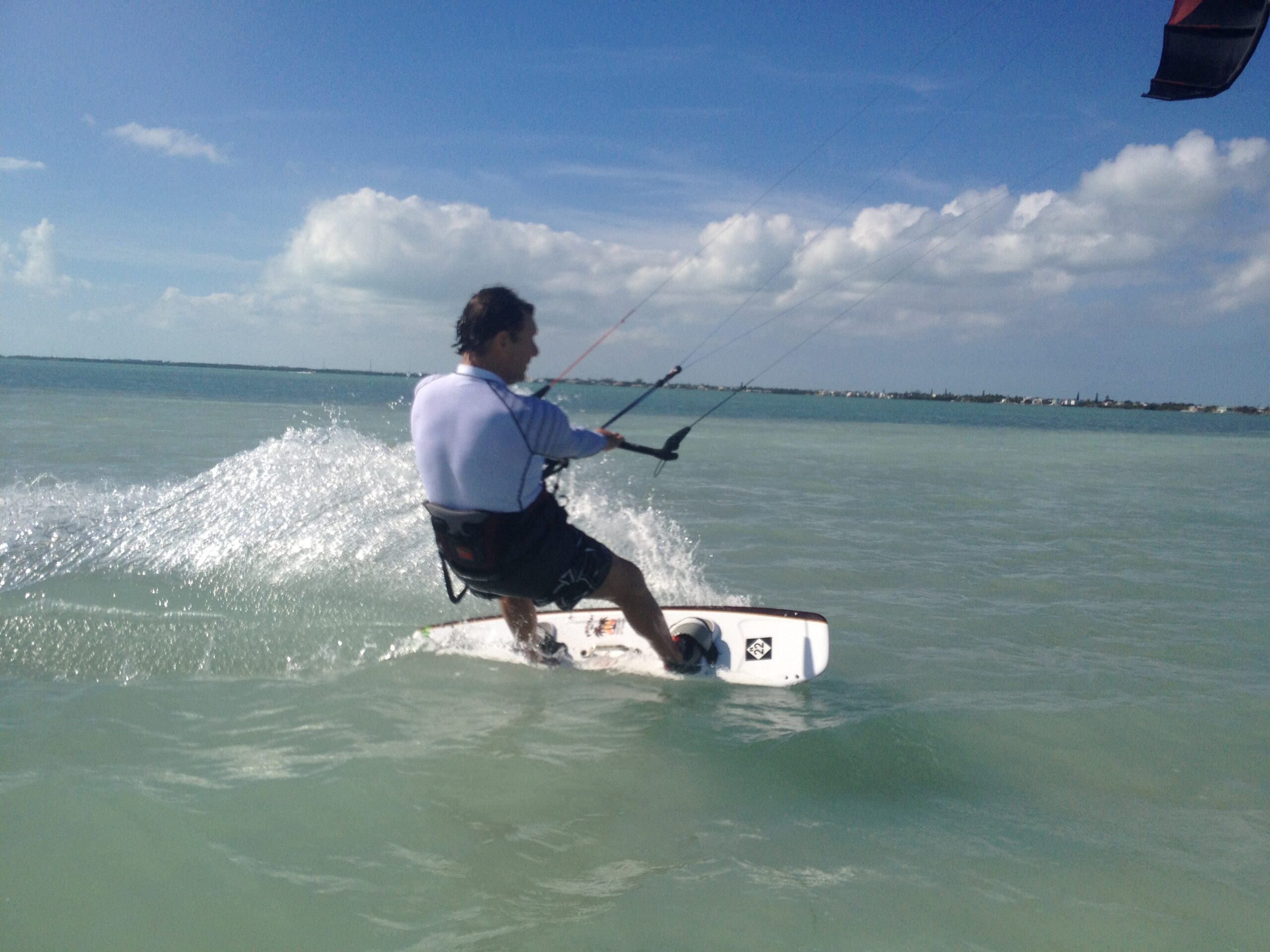How to stay up wind.
Once you learn how to ride the board, it’s time to learn how to stay up wind. Here are a few tips to help you stay up wind.
Leaning back is key to kiteboarding up wind. In most cases, if you do not lean back, you will not be able to kiteboard up wind. Leaning back allows the board to “edge” or “cut in” to the water at a steeper angle giving it more direction and stability. Most people don’t realize how far they can lean back and still ride. As long as there is enough wind for the kite to hold you up, you can lean all the way back and drag your hand in the water. During lessons we have the student dip their hand in the water while riding to get them to understand how far they can lean back and still ride. If you do not lean back and the board is flat on the water, it has very little direction and won’t allow you to go up wind. You want to lean towards the heal side of the board and a touch towards the trailing edge. Leaning too much towards the trailing edge will slow you down and not allow you to edge or cut in enough to go up wind.
Keeping your back leg bent a little and front leg straight will orientate the kiteboard in the correct general position for riding up wind. Once you are up and riding, play around with how bent and how straight your back leg is. There is a happy medium on how bent or straight your leg should be. Straightening out your back leg a little will force the front of the kiteboard a little farther up wind. Too much will slow the board down, and too little will aim the board further downwind.
Keeping your kiteboarding kite at 45 degrees or lower when you are riding will help you stay up wind. If the kite is too high in the sky, it will have more force towards downwind rather than to the side of the wind window.
Make sure you have enough wind for the kiteboarding gear you are using. Sometimes there is simply not enough wind. Watch the actual wind speed at your particular kiteboarding location. Here in The Florida Keys we use the NOAA website to see the actual, it’s updated every hour at about 20 minutes after the hour so you can see what the wind has been doing. Once you get familiar with the wind speeds, you will know what wind speed is good for you and what wind speed is no good. You can check our links page here on the Florida Keys Kiteboarding website to see the weather websites we use on a daily basis.
Make sure you have the correct kite size for the wind at hand. Too small a kite will not provide you with enough power to kiteboard up wind, and too big of a kite will pull like a freight train, making it hard to edge and it will wear you out fast.
Make sure your kiteboarding kite is trimmed properly. With proper wind, your kite should not fall out of the sky backwards if you hold the bar all the way in. If that happens, pull the trim strap in an inch or so and test it again. If you have to lean forward stretching your arms out to depower your kite, pull your trim strap a little so that you can lean back comfortably. When you ride leaning forward, your board is flat on the water, not allowing it to edge. If you have your trim strap pulled in too far, the kite may not be able to develop the power you need to ride up wind.
Make sure your kiteboard size is correct. Generally speaking, the lighter the wind is, the bigger the board should be. Bigger boards will get up on plane a little easier, and they do not take as much force to stay up on top of the water and plane. A smaller kiteboard will require a little more kite power to stay up on top of the water. Sometimes your kiteboarding kite may be a little too big, so if you have plenty of pulling power from the kite and you are using your big board and still not making it up wind, try a little smaller board. The kite may be giving you too much power to properly edge a big kiteboard.
Your foot position can help your up wind riding also. If your feet are too far towards the toe side of the kiteboard, it makes it harder to edge the board. If you feel your shin muscles burning, it means your feet are too forward on the board. Back your feet up towards the heal side of the kiteboard about an inch at a time until your feet are in the right spot. You should be able to lean back comfortable with out having to try to force your toes to your nose to get the board to edge or cut in. Tighten your kiteboarding bindings a little at a time so that your feet can’t go too far forward.
Sometimes current can hinder your ability to kiteboard upwind. If the current is going the same way as the wind is, it’s like losing some wind speed. If the current is going the opposite way of the wind, it’s like gaining some wind speed.
Keep in mind that the better you are at kiteboarding, the smaller the kite you will be able to use and the lighter the wind you will be able to kiteboard in and still stay up wind. The more you kiteboard the more you will be able to vary from these tips stay up wind.


No responses yet